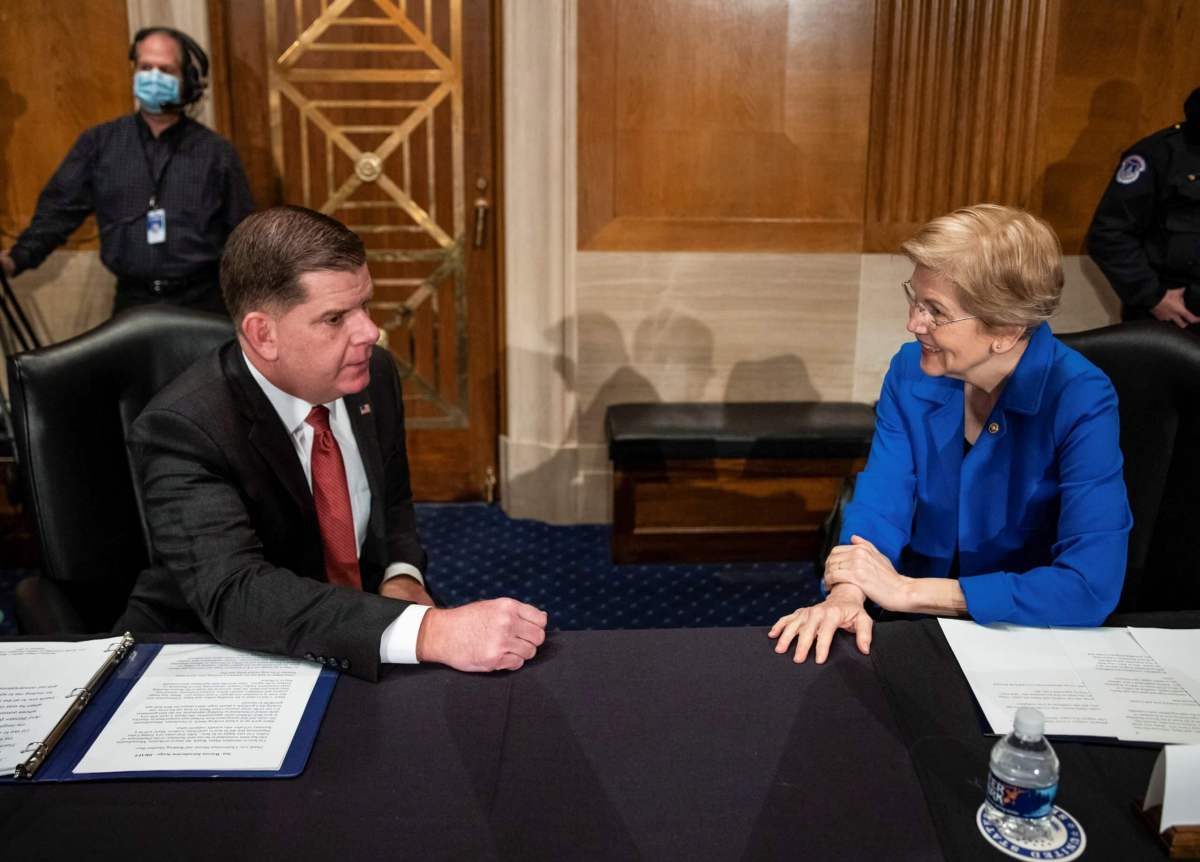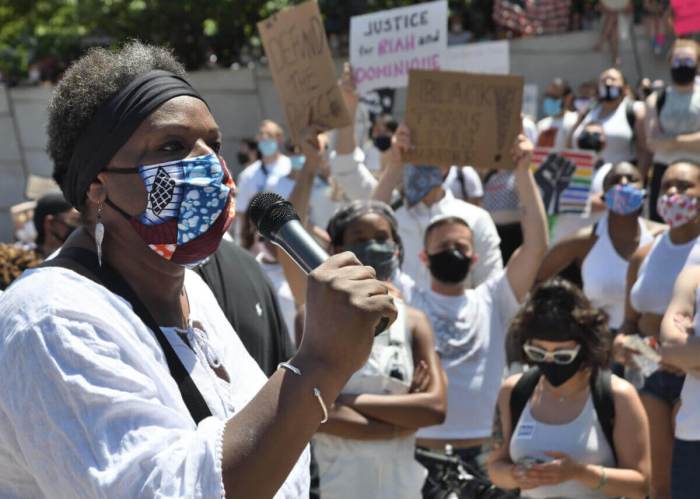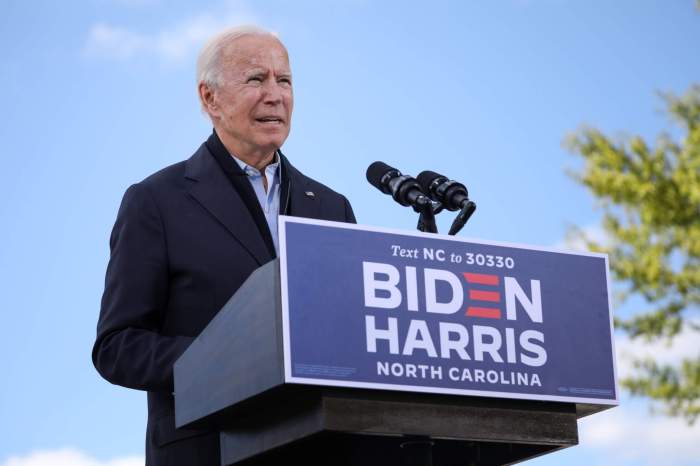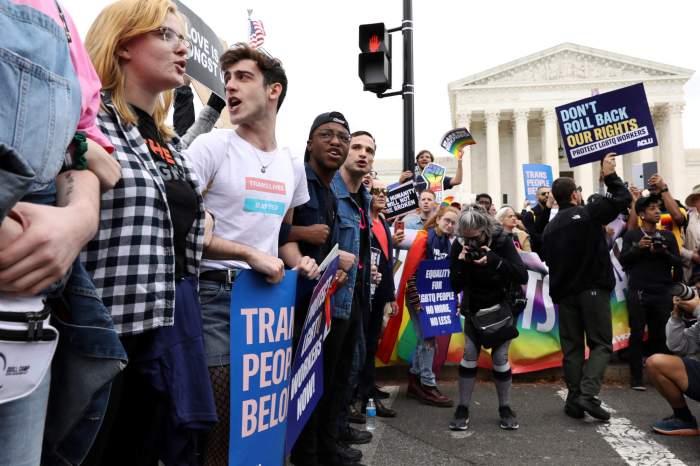With public consciousness of income inequality widespread in the US and the demand for a $15 minimum wage nationwide growing louder every day, President Joe Biden comes into office with high expectations about what he must do to help the American worker.
His campaign promises reflected that reality, spelling out an agenda that not only endorsed the doubling of the federal minimum wage but also backed a broad package of steps to strengthen the rights of workers to organize and win good-faith bargaining from their employers and to overturn the corporate practice of forcing employees with workplace complaints into binding arbitration likely to be less favorable to them than taking their claims to court would be.
The new president’s ambitious agenda — coupled with his decades-long record in Washington and his nomination of Boston Mayor Marty Walsh, a longtime union president, as his labor secretary — led a Cornell University union expert to label Biden the most labor-friendly president in 60 years.
The impact that enacting the administration’s labor agenda would have on LGBTQ Americans can’t be quantified with precision due to the lack of comprehensive and reliable data on the community’s workforce participation, but what occupational and economic data exists make clear that there is a lot to gain. Studies have repeatedly shown that the LGBTQ population has higher rates of poverty than American society as a whole, that queer Americans are disproportionately represented in service industries like food and restaurants, healthcare, education, and retail — all sectors currently the focus of intensive unionizing efforts — and that transgender workers have a higher rate of union membership than the US workforce as a whole.
The labor movement wields considerable political muscle, particularly within the Democratic Party, but it does not have the clout it enjoyed in the decades following World War II. According to the US Bureau of Labor Statistics, 10.8 percent of the American workforce — roughly 14.3 million workers — are union members. By contrast, in 1983, the earliest year for which the Bureau has comparable data, 20.1 percent of American workers — roughly 17.7 million — were union members. The Biden campaign cited statistics from the mid-1950s putting the percentage of unionized workers as high as 35 percent.
The decline in union membership is largely due to the diminished role that heavy industry — long the main target of union efforts — plays in the American economy, but offsetting growth has occurred in service industries, where the bulk of US job growth is now occurring, and among public sector employees.
In addition to the loss of industrial jobs, organized labor has also faced challenges from stepped up right to work initiatives — with provisions allowing employees to opt out of paying dues to a union approved by the majority of their fellow workers — coming from Republican-led state governments. In the past decade, under Wisconsin’s former GOP governor Scott Walker, that state initiated a trend to kneecap unionizing efforts among public sector employees.
Like most institutions in American society, organized labor’s embrace of LGBTQ rights evolved only gradually. Rob Epstein’s documentary “The Times of Harvey Milk” chronicles the San Francisco gay activist and city supervisor’s work with labor allies as early as the 1970s, but what’s striking about the account is the exceptional nature of that solidarity. Over the decades that followed, LGBTQ activists struggled to win union support for issues ranging from domestic partnership to transgender healthcare benefits and marriage equality.
According to Jerame Davis, executive director of Pride at Work, a recognized affiliate of the AFL-CIO that aims to strengthen the voice of LGBTQ union members nationwide, the picture has changed dramatically in recent years. Several powerful unions are now headed by out LGBTQ leaders — including Randi Weingarten at the American Federation of Teachers (AFT), Stuart Appelbaum at the Retail, Wholesale and Department Store Union (RWDSU), and Mary Kay Henry at the Service Employees International Union (SEIU).
Davis acknowledged that the biggest push for recognition was required at unions in male-dominated industries, but pointed to representatives from the United Steelworkers and the International Brotherhood of Electrical Workers who now sit on the Pride at Work board, as well as strong support from unions such as those representing bricklayers.
He specifically noted that union contract negotiators now include trans-inclusive healthcare benefits in their bargaining package — and pointed to statistics from the National Center for Transgender Equality indicating that as many as 15 percent of employed trans Americans say they belong to a union, almost half again as high a rate as among the US workforce generally.
A study released this past fall from the UCLA Labor Center found that among more than 1,000 members of the United Food and Commercial Workers (UFCW) surveyed, a third of whom identified as LGBTQ, there was very strong support — as high as 87 percent — for workplace protections and benefits for queer employees.
A 2018 commentary in The Advocate from Richard Trumka, president of the AFL-CIO, recounted how as president of the United Mine Workers in the 1980s he oversaw some of the first negotiated same-sex couple benefits in the nation.
Though comprehensive data on what industries LGBTQ people work in does not exist, Davis pointed to 2018 findings that the Human Rights Campaign drew from a University of Chicago research institute indicating that 40 percent of the community works in five industries where union organizing has either achieved big wins or is being aggressively pursued: restaurants and food services (15 percent); hospitals (7.5 percent); K-12 education (seven percent); colleges and universities (7 percent); and retail (4 percent). Only 22 percent of the general population are employed in these same industries.
Educational workers have an especially high rate of unionization, Davis said, while the food service industry is a target of both UFCW and RWDSU organizing; retail is also an RWDSU target; and hospitals are a focus of SEIU efforts.
Davis pegged the number of unionized LGBTQ workers in the US somewhere between half a million and a million in total.
A separate study taken from a different perspective published by the London School of Economics Business Review showed that gay men were overrepresented compared to men generally as flight attendants, hairstylists, nurse practitioners, actors, news media professionals, and artists, while lesbians were overrepresented compared to women generally as psychologists, probation officers, social service managers, and mechanics and installers for automotive products, elevators, heating and cooling devices, and home appliances.
Both Davis and RWDSU’s Appelbaum emphasized that the key priority they see for American workers today is safety during the pandemic, with each emphasizing the urgent need to enact Biden’s COVID relief package.
“Right now, we have to see that people get taken care of,” Davis said.
Appelbaum talked about RWDSU’s work over the past year in highlighting the dangers of work in poultry plants, which are concentrated in the South.
“In many ways, these are the new plantations,” he said, noting that many workers in such plants were told initially that protective gear was not needed on the production line. PPE, Appelbaum said, might be provided to supervisors, many of them white, while the workers themselves, largely African-American, went without. Some plants, he added, hung Saran Wrap between workers rather than using plexiglass.
“We embarrassed the employers to treat workers better,” Appelbaum said.
The focus on COVID relief is also apparent in the Biden administration’s early dialogue with organized labor. On February 17, the president met with 10 labor leaders, and the White House readout of the gathering stated that its focus was on the COVID package, known formally as the American Rescue Plan, as well as an infrastructure initiative to “create millions of jobs in R&D, manufacturing, and clean energy.” The unions represented were all from the industrial sector, such as engineers, iron workers, aerospace workers, and a variety of building trades. Service workers unions, where much of the growth in organized labor membership is happening, were not present.
Unmentioned in the White House readout was any discussion of the Protecting the Right to Organize (PRO) Act, a measure that bundles many of the initiatives endorsed by Biden’s campaign to strengthen the ability of workers to organize for collective bargaining rights, penalize companies that retaliate against such labor activism, and weaken the right to work laws that exist in 27 states. Significantly, the measure would also crack down on corporate policies that classify workers as independent contractors rather than employees eligible to join union organizing units — provisions that could deliver relief to gig economy workers currently under the unfettered sway of unresponsive ownership.
These are all steps that Biden has endorsed, and the Democratic-controlled House passed the PRO Act last February in a 224-194 vote, largely though not exclusively along party lines. Lamar Alexander, the former Tennessee Republican senator who then chaired the Health, Education, Labor and Pensions Committee, refused to give the measure a Senate hearing.
Washington State Democrat Patty Murray, who is the lead sponsor on the measure in her chamber, now chairs that committee, but Gay City News’ calls into her office and into the committee were not returned.
Pride at Work’s Davis, RWDSU’s Appelbaum, and Gene Carroll, co-director of the New York State AFL-CIO/Cornell University Union Leadership Institute agree that the PRO Act is a crucial piece of legislation to push through Congress while Democrats are in charge.
Speaking to its importance, Appelbaum observed, “The policy in this country is supposed to be pro-collective bargaining, and has been that way since the New Deal, but that is not happening.” What’s critical, he said, is the pushback against right to work laws in more than half the states.
In Davis’ view, the PRO Act would make a “material change” in the balance between management and labor in the nation.
Carroll pointed with particular concern to the attack on public sector employees first launched by Scott Walker in Wisconsin and copied elsewhere.
“Public sector workers became the bogey man,” he said, “their jobs seen as sinecures” with generous benefits and little accountability for delivering results.
Appelbaum, fresh off a victory in organizing employees at the AIDS housing and service group Housing Works, also pointed to his union’s efforts to organize workers at an Amazon fulfillment plant in Alabama.
“The Amazon fight energizes me,” he said. “Amazon is transforming industry after industry, and we have no choice but to take on this fight. The work there is dehumanizing. Workers get their assignments from robots, they are monitored by apps, and can be fired by text.”
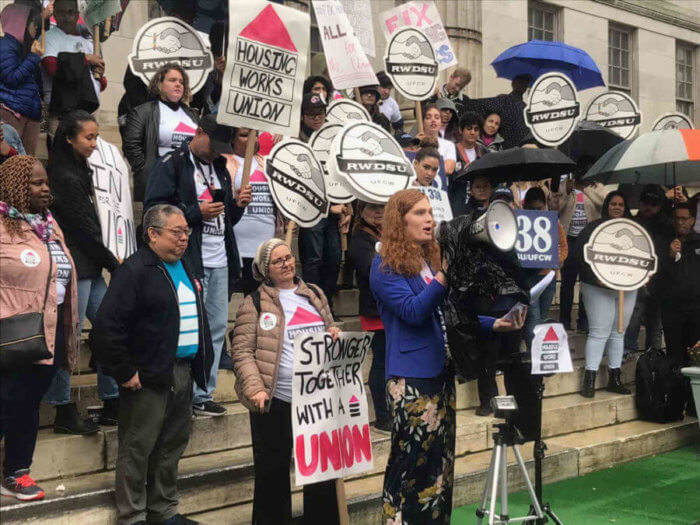
The key question about the PRO Act for the administration, Murray in the Senate, and labor advocates is whether 60 votes can be found to overcome a filibuster by Republican opponents. Carroll noted labor’s longstanding tradition of supporting candidates on both sides of the aisle in the knowledge that Republican as well as Democratic votes are typically needed to ensure victory. He acknowledged, however, “In this age of Trump, it is a very different landscape.”
In the face of extreme partisan polarization, he said, “I would like to see what labor’s analysis is about whether they could win 10 or 11 Republican votes.”
Davis was not upbeat about that possibility. Though at least two Democrats — Arizona’s out LGBTQ Kyrsten Sinema and West Virginia’s Joe Manchin — have firmly rejected the idea of eliminating the filibuster altogether and thereby sidestepping the 60 vote requirement, Davis suggested they could be brought around if Republicans repeatedly stonewall key Biden initiatives. (The COVID relief package seems headed for passage through the arcane budget reconciliation process that requires a simple majority that would include Vice President Harris as the tie-breaker.)
“It’s easier to find two votes to kill the filibuster than 10 GOP votes to pass PRO Act,” Davis said.
Carroll would not preclude the possibility of enacting the measure on a bipartisan push bringing in 60 or more votes, but said, “Biden would have to commit to a 100-percent focus, with all the prestige of the White House brought to bear.” His faith, it seems, is based in part on his assessment that Biden is the most pro-labor president since John F. Kennedy.
Strikingly, Carroll and Davis agreed that winning passage of the $15 federal minimum wage — assuming, as seems likely, that the Senate parliamentarian will disallow its inclusion in the COVID relief measure under budget reconciliation rules — could be an easier bipartisan lift.
“There might be 10 Republicans out there who support the minimum wage increase,” Davis said.
Carroll pointed to the proposal’s strong public support as shown in polling and the clear evidence that a substantial boost in the minimum wage raises living standards.
“That’s powerful information,” he said.
The main risk in trying to woo Republican support, Carroll said, is that it might involve extending the phase-in period for the increase — at a time when some economists and labor advocates on the left are already saying that $15 is insufficient. Phasing in an increase over six years would allow inflation to bite into both the improvements in living standards and the multiplier effect of the lowest income Americans having more money to plow back into the economy.
Another key element affecting the ability of American workers to stand up for their rights is the growing use of binding arbitration by corporations to force employees to settle complaints in a process devised by the employer rather than being able to seek redress in the courts. Binding arbitration has long been a factor in organized labor disputes, but the terms of such arbitration are hashed out on behalf of workers by their union negotiators. But binding arbitration when forced on non-unionized employees is typically the product of a system devised by corporations, without input from their employees.
The American Civil Liberties Union points to statistics estimating that the practice already impacts more 60 million US employees — a number expected to grow to more than 85 million by 2024. The ACLU, describing binding arbitration as “slamming the courthouse doors in the face of victims of workplace harassment and discrimination,” cites statistics showing that the practice discourages workplace complaints, is less likely to result in a favorable verdict for a worker complaining, and even when a worker prevails yields a less generous settlement.
Terri Gerstein, director of the State and Local Enforcement Project at Harvard Law School’s Labor and Worklife Program, wrote in the New York Times about Big Tech companies several years ago waiving their binding arbitration regulations on sexual harassment claims in the face of the #MeToo movement, but argued that other forms of harassment and discrimination remained straightjacketed by binding arbitration requirements.
Since 2019, Senator Murray and House Democrats Jerry Nadler of New York and Bobby Scott of Virginia have sponsored the Restoring Justice for Workers Act, while Georgia Democratic Representative Hank Johnson and Connecticut Democratic Senator Richard Blumenthal are pushing the Forced Arbitration Injustice Repeal or FAIR Act, both aimed at curtailing forced binding arbitration. The concept is one Biden is also on the record in favor of.
The arbitration issue is an important factor to consider as Oregon Senator Jeff Merkley and out gay Rhode Island Representative David Cicilline this past week, with Biden’s support, reintroduced the Equality Act, which would extend the nondiscrimination protections of the 1964 Civil Rights Act and similar legislation that followed — involving employment, housing, public accommodations, access to credit, and educational institutions — to complaints based on sexual orientation and gender identity. The measure would codify the Supreme Court victory on employment discrimination resulting from last June’s ruling in Bostock v. Clayton County, Georgia — and vastly broaden its purview.
Like some many other Biden initiatives, the legislative strategy regarding the need for 60 votes in the Senate will be a critical factor. Any resolution — or lack of — on the binding arbitration issue, however, will also be an enormous factor in what teeth Bostock and the Equality Act can bring to protecting LGBTQ workers.
To sign up for the Gay City News email newsletter, visit gaycitynews.com/newsletter.

